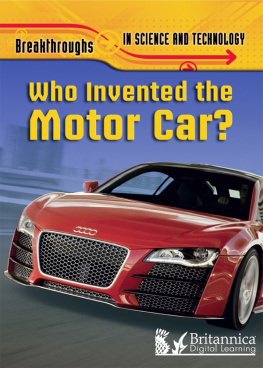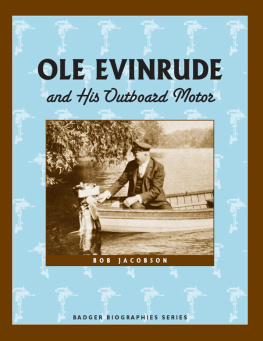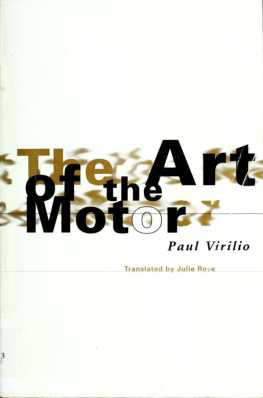Brian Williams - Who Invented the Motor Car?
Here you can read online Brian Williams - Who Invented the Motor Car? full text of the book (entire story) in english for free. Download pdf and epub, get meaning, cover and reviews about this ebook. year: 2015, publisher: Britannica Digital Learning, genre: Non-fiction. Description of the work, (preface) as well as reviews are available. Best literature library LitArk.com created for fans of good reading and offers a wide selection of genres:
Romance novel
Science fiction
Adventure
Detective
Science
History
Home and family
Prose
Art
Politics
Computer
Non-fiction
Religion
Business
Children
Humor
Choose a favorite category and find really read worthwhile books. Enjoy immersion in the world of imagination, feel the emotions of the characters or learn something new for yourself, make an fascinating discovery.
- Book:Who Invented the Motor Car?
- Author:
- Publisher:Britannica Digital Learning
- Genre:
- Year:2015
- Rating:4 / 5
- Favourites:Add to favourites
- Your mark:
- 80
- 1
- 2
- 3
- 4
- 5
Who Invented the Motor Car?: summary, description and annotation
We offer to read an annotation, description, summary or preface (depends on what the author of the book "Who Invented the Motor Car?" wrote himself). If you haven't found the necessary information about the book — write in the comments, we will try to find it.
Written in British English. Who Invented the Motor Car? looks back at the history of the cara machine that we could not imagine living without today.
Who Invented the Motor Car? — read online for free the complete book (whole text) full work
Below is the text of the book, divided by pages. System saving the place of the last page read, allows you to conveniently read the book "Who Invented the Motor Car?" online for free, without having to search again every time where you left off. Put a bookmark, and you can go to the page where you finished reading at any time.
Font size:
Interval:
Bookmark:

Breakthroughs
IN SCIENCE AND TECHNOLOGY
Who Invented the
Motor Car?

E-book published in 2015 by Encyclopdia Britannica, Inc., in association with Arcturus Publishing Limited, 26/27 Bickels Yard, 151-153 Bermondsey Street, London SE1 3HA. Britannica, Encyclopdia Britannica, and the Thistle logo are trademarks of Encyclopdia Britannica, Inc.
ISBN 978-1-62513-371-7 (U.K. e-book)
This edition first published in 2010 by Arcturus Publishing
Copyright 2010 Arcturus Publishing Limited
All rights reserved
Planned and produced by Discovery Books Ltd.
www.discoverybooks.net
Managing editor: Laura Durman
Editors: Amy Bauman and Penny Worms
Designer: Ian Winton
Illustrator: Stefan Chabluk
Picture Credits
Audi: cover. Corbis: title page and .
Every attempt has been made to clear copyright. Should there be any inadvertent omission, please apply to the copyright holder for rectification.
SL001447US Supplier 03, Date 0510
Contents
From animal power to engines
Few inventions changed peoples lives more than the motor car. Before the 1700s, all land vehicles, such as carts and carriages, were pulled by animals. Most people could not afford a horse or any sort of road vehicle and had to rely on their legs to carry them to where they wanted to go. Then came two revolutionary inventions: first the steam locomotive, and then, in 1885, the motor car.
From steam to gas
Steam engines were first used in the early 1700s to drive pumps, and later to power ships, trains and factory machines. Steam was also tried on the road, but it was not very successful. The modern revolution in road travel really began with the invention of the internal combustion engine. Slowly, motorized cars and trucks replaced horse-drawn carriages and ox-drawn carts. Since the first cars appeared on the roads, over one hundred years ago, scientists and engineers have made many more improvements in auto-technology, to produce the fast, comfortable and safe cars we use today. Those changes are ongoing, as companies look to design cars for the future that use lighter materials and run on cleaner, alternative fuels.
Putting the pieces together
Many of the early car pioneers worked alone. They made parts themselves, coming up with and borrowing ideas, and adapting useful, existing technology for example, from the steam engine and the bicycle. Pioneers were also quick to adopt new technologies, such as electric batteries or air-filled rubber tyres. Often two inventors would have the same idea independently. Some inventors became rich and famous, founding international businesses. Others gave up and were soon forgotten.

Paris, France, in the 1860s. Horse-drawn carts and carriages rattled along city streets, but most people had to walk to wherever they needed to go. But less than 30 years later, cars had joined the Paris street traffic.

In Paris today, the streets are crowded with cars. Cities have had to adapt to the car an invention that many people think they could not live without.
T HATS A F ACT !
In 1900, there were fewer than 25,000 cars in the world. By 1910, that number had risen to about one million. Today, there are more than one billion. Car manufacturers make more than 60 million cars every year.
Over the years, each new piece of car technology has been a breakthrough, but when Karl Benz drove his first car in 1885, he started a revolution. The car created new industries, changed the way people spent their leisure time, and altered the landscape. Today, with millions of cars on busy roads across every continent, the cars success has become a challenge to science. Too many cars burn too much petrol and give off too much harmful waste. The challenge now is to make new cars that use fuels that are less harmful to the environment. Todays science breakthroughs will create the cars of tomorrow.
Steam power
For thousands of years, no human travelled faster than a horse could gallop. After the invention of the first working steam engine in 1712, inventors began to dream of a horseless carriage, a vehicle that could travel under its own steam.
The steam engine
The ancient Greeks made steam toys for fun, but the first person known to put steam power to work was British inventor Thomas Newcomen. His 1712 atmospheric engine pumped water out of mineshafts and tunnels. A fire under a boiler heated water to turn it to steam. The steam entered a cylinder with a piston inside. The piston was forced up and down to work the pump. Similar pump mechanisms had existed for thousands of years, but powering one by steam was new. Other steam engines followed to power factory machines. In the 1760s, Scottish engineer James Watt built a steam engine with a sealed cylinder at both ends, to make it double-acting the steam forced the piston down as well as up, giving more power. Watt also devised a way to turn the up and down piston motion into a round and round wheel motion.
Inventors show the way
So, if a steam engine could drive a factory machine, why not a vehicle? In 1769, Frenchman Nicholas Cugnot fitted a steam engine to a three-wheeled gun carriage. It trundled along at 6 km/h (3.7 mph) but crashed and was soon forgotten. It was Englishman Richard Trevithick who made the breakthrough. He discovered that using steam at high pressure produced more power. Watt thought this dangerous because the boiler could explode, but Trevithick went ahead in 1801 with his first high-pressure steam carriage, the Puffing Devil. In 1803, he drove his second vehicle from Cornwall to London over 500 km (300 miles). Given the terrible roads, it was a miracle of engineering and persistence.

This is Newcomens 1712 steam engine. Steam from the water boiler was let in through a valve to the cylinder, while the piston was at the top. A spray of cold water cooled the steam, which condensed, lowering the air pressure inside the cylinder. Higher air pressure outside pushed the piston down. The piston drove a rocking beam linked to a pump. The weight of the pump rod pulled the piston up, for the cycle to begin again.

This modern painting shows Richard Trevithicks 1803 steam carriage. A wooden carriage sat on two huge, iron wheels, with a small front wheel for steering. The same tricycle design was used for Benzs first automobile in 1885.
In the United States, Oliver Evans had a similar idea. In 1802, he showed his new Amphibious Digger in Philadelphia. Evans made it to dredge mud from the harbour, and it even looked like a boat on wheels, but the Digger needed no horses or sails.
It frequently happens that two persons, reasoning right on a mechanical subject, think alike and invent the same thing without any communication with each other.
Font size:
Interval:
Bookmark:
Similar books «Who Invented the Motor Car?»
Look at similar books to Who Invented the Motor Car?. We have selected literature similar in name and meaning in the hope of providing readers with more options to find new, interesting, not yet read works.
Discussion, reviews of the book Who Invented the Motor Car? and just readers' own opinions. Leave your comments, write what you think about the work, its meaning or the main characters. Specify what exactly you liked and what you didn't like, and why you think so.















